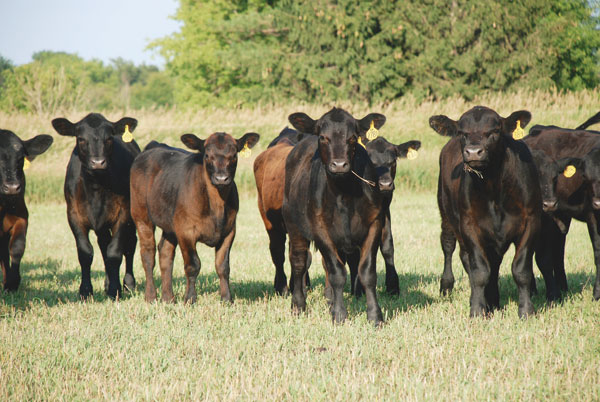Feeder cattle continued to bring strong demand last week, helped along by higher week-to-week futures prices.
October 7, 2017

The cork is just beginning to pop on spring calves making their way to town, but early on, the market underpinning appears solid.
Leaf through a number of weekly auction reports from across the country and buyers continued to pay steady to mostly higher prices for feeder-weight cattle and heavier, weaned calves. Bawling, un-weaned calves continued to face pressure.
Specifically, the Agricultural Marketing Service (AMS) pegged feeder steers and heifers at mostly steady to $7 per cwt higher on the week. Calves were mixed from $4 lower to $5 higher.
Aggressive fed cattle slaughter and apparent packer profitability continued to buoy markets. Higher futures prices added support, though trading throughout most of the week was of the two-sided variety.
Except for 22¢ higher in recently minted away Sep, Feeder Cattle futures closed an average of $2.18 higher week to week on Friday ($1.72 to $2.92 higher).
Except for 57¢ and 45¢ higher in the back two contracts, Live Cattle futures closed an average of $1.79 higher ($1.37 to $2.15 higher).
That, along with steady to higher prices for fed cattle at auction earlier in the week, likely explain at least part of cattle feeders’ confidence to take a pass on packer bids through late Friday afternoon.
For instance, buyers paid a weighted average price of $108 per cwt at Wednesday’s weekly Fed Cattle Exchange auction (delivery at 1-9 days and 1-17 days).
Similarly, slaughter steers sold mostly steady to $1 higher at Sioux Falls Regional Livestock on Wednesday. Slaughter heifers traded steady to $3 higher.
Established prices for country trade the previous week were at mainly $108 on a live basis and $172 in the beef.
Wholesale beef values continued at a sluggish pace, too.
Choice boxed beef cutout value was 60¢ higher week to week on Friday at $197.22 per cwt. Select was $1.27 lower at $187.23.
“The Choice beef market remains fairly stagnant compared to last week, while no one is showing Select beef much support either,” says Andrew P. Griffith, agricultural economist at the University of Tennessee, in his weekly market comments. “Consumers have continued to purchase beef throughout 2017, which remains a strong sign for the cattle complex, but the early fall period is simply a difficult time to push beef prices higher given the quantity of beef being produced. Beef production tends to be seasonally highest during the early weeks of fall, which is a factor of increasing slaughter rate and increasing slaughter weights. There have been several weeks recently when federally inspected cattle slaughter has dared to reach 650,000 head per week, compared to the five-year average when bumping up against 620,000 head per week was a big deal.”
Although dressed weights continue to increase seasonally, Griffith says they remain 10-15 pounds lighter than a year ago.
“Larger slaughter and relatively lower dressed weights are largely due to increased cow slaughter compared to last year, though steer and heifer slaughter are above year-ago numbers,” Griffith says.
U.S. beef exports continue steamy pace
International demand for U.S. beef continues to help underpin cattle prices.
Export value in August (most recent data) was the second-highest on record at $679.1 million, up 20% from a year ago, according to statistics released by USDA and compiled by the U.S. Meat Export Federation (USMEF).
In terms of volume, August beef exports of 112,069 metric tons were the most this year and 5% more than a year earlier.
For January through August, beef exports increased 10% in volume and 16% in value ($4.65 billion) compared to the first eight months of 2016.
Export value per head of fed slaughter averaged $290.05 in August, up 13% from a year ago. Through August, per-head export value was up 9% to $275.81.
Incidentally, August beef exports to market-leading Japan were 22% more than a year ago and the largest of the post-BSE era. Export value to Japan increased 35% and broke the $200 million mark ($200.05 million) for the first time since May 1996. For January through August, exports to Japan were up 23% in volume and 30% in value ($1.28 billion).
You’ll recall that Japan’s frozen beef safeguard was triggered in late July, increasing the duty on frozen beef imports from the U.S.—and other suppliers without a trade agreement with Japan—from 38.5% to 50%. Although it will likely take some months to see the true impact of the higher duty, August demand was not significantly affected, according to USMEF.
About the Author(s)
You May Also Like



.png?width=300&auto=webp&quality=80&disable=upscale)
.png?width=300&auto=webp&quality=80&disable=upscale)
